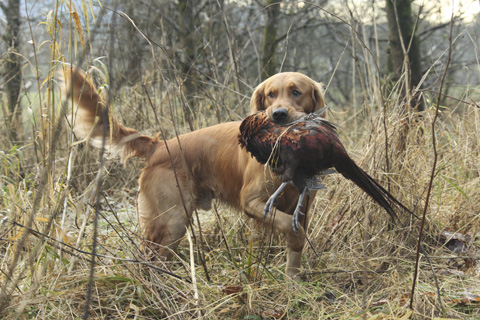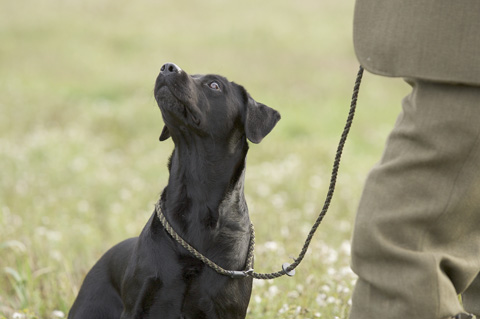Win CENS ProFlex DX5 earplugs worth £1,149 – enter here
Gundogs: Where are the dual champions?
Dual champions: the gap between working dogs and show dogs has become a chasm. Is there any hope of seeing a return of dual champions?

I acquired my first golden retriever from a farm near Wisbech in 1972 for £18. Out of an unregistered bitch’s third litter, he made the transition from chasing balls (after I came to realise what I might be able to do with him) to being a steady retriever who could be handled. Other than the occasional indiscretion (typical of dogs called Sam, according to June Atkinson), he could more than hold his own in Open Working Tests. More to the point, after we moved to Bath he showed a prodigious appetite for work, collecting thousands of birds over many seasons on the Castle Combe shoot with the sort of drive that many commented on.
So far unremarkable, you might think. What’s incredible, from today’s standpoint, is his breeding. By Honeyboy Zimba, sired by a 1968 winner at Crufts, and out of Sultan’s Golden Pride, he had but one recognisable working name in his pedigree. A great grand sire on the dam’s side was Palgrave (Eric Baldwin’s prefix) Joe: otherwise it was wall-to-wall undistinguished show dogs. What his case demonstrates is that dogs that look distinctly unpromising on paper can often have surprising capabilities.
The law of probabilities
In 1976 I got my second dog (Holway Swift) from June Atkinson, who was good enough to win me a Novice Stake and Reserve in the Golden Retriever Club Two-Day Open in 1980. The advice at the time was to avoid show breeding like the plague. It was good advice too, for when it comes to breeding we are dealing not with certainties but with probabilities: we are seeking to maximise the chance that a pup from a given sire and dam will have certain desirable capabilities. No one is claiming that only dogs with such breeding will have those qualities: merely that if we hope to inject a degree of predictability into what can otherwise be a chancy process, that is the way to go. That’s as true of show dogs as it is of working dogs.
A chasm of wilful misunderstanding
The result now, in very general terms and with honourable exceptions, is a chasm of what can seem almost wilful misunderstanding. Enthusiasts from the two spheres often talk past each other with the sort of megaphone diplomacy that generates much heat while casting little light. Many look back to that ‘land of lost content’ even though there is little hope of ever walking there again: an era when dogs could excel in both the field and on the bench but which is virtually irrelevant to our present concerns.
The distant golden age
Examples of dual-purpose excellence now seem very distant. The last retriever to have achieved both Champion and Field Trial Champion titles was the golden Int Dual Ch David of Westley who did it both here and in Ireland in 1957. In the period before the Second World War five show champions and five dual champions between them qualified seven and nine times for the IGL Retriever Championship, and Major Twyford’s Labrador Dual Ch Titus of Whitmore won it twice in succession in 1923 and 1924. Already by the 1930s, though, the number of dual and show champions running in the IGL had declined, and the last dual champion to do so was Ronald Macdonald’s labrador dog, Rockstead Footspark in 1953.
Exceptions that prove the rule
The last show champion to gain an award in the IGL Championship was the golden Ch Dai of Yarlaw, who gained a Diploma of Merit in 1964. Since that period, in goldens, only two bitches have had any pretension to the dual champion title. Derek Price-Harding’s Ch Deremar Rosemary, born in 1970, was wholly show bred: indeed, she was sired by Ch Camrose Cabus Christopher who was, until 1986, the breed’s CC record holder. She gained her bench title and actually won an Open Stake, becoming the last show champion to compete in the IGL Championship when she ran at Sandringham in 1977. A decade later Daphne Philpott took Standerwick Thomasina to her bench title and gained open stake awards, but never qualified for the IGL. She was, moreover, sired by FTCh Holway Spinner and had FTChs on her dam’s side, so it was more a case of a working-bred dog winning in the show ring under the guidance of a handler with a huge reputation in that sphere. What such exceptions prove is the rule that the demands of the spheres of show and work appear impossibly distinct.
It’s not too late
The need to be in good, hard condition for increasingly demanding work in the field cannot sit easily with the ‘substance’ which, however euphemistically, still seems to be a precondition for success in the show ring. The Kennel Club’s ‘Fit for function: fit for life’ campaign can only be beneficial, but it will bring change of the slow drip variety unless accompanied by the fundamental transformations of mindset that are desperately needed. Such changes are a matter of really looking, rather than just presuming that a dog not in its ‘default mode’ cannot be capable of performing effectively. Nothing less than a paradigm shift will do and such a change cannot be engineered. It will be the result of key individuals, particularly judges, setting aside presuppositions that they have long taken for granted. We badly need to re-think a debate dominated by tired old clichés, and that’s why that distant ‘golden age’ is barely relevant. 
Really looking will involve the recognition that there are many working-bred dogs that have excellent qualities of conformation and, by the same token, the recognition that dogs of predominantly show breeding might, in the right hands, be capable of effective work. I cannot deny the lesson that line-breeding is invariably associated with success in working dogs. The point about probabilities with which I began is a really significant one. I am equally sure, however, that we have not – though it might seem an obvious conclusion to draw – reached a point of genetic drift: a point of complete separation.
Here comes the scientific bit…
The analysis of pedigrees bears that out. Golden retrievers are the only breed that has complete pedigree data from the very beginning of its existence, and Eileen Caisley, who developed the Standfast Pedigree Database, has done some preliminary analysis using a program called Pedscope. It uses several genetic programs and enables the percentage of blood contributed by ancestors to be calculated. This can yield fascinating results. My own FTCh Holway Martina of Wydcombe, for instance, has 2,551 ancestors and, although the first 30 or so are indeed very different from typical show pedigrees, at number 21 you have Culham Brass, whelped in 1904, contributing 13.40% of blood, whilst one place behind is Normanby Balfour, 1911, contributing 13.10%: both ahead of Holway Flush of Yeo, 1960, and Holway Quincey, 1989, who each contribute 12.50%. What Pedscope shows is the way genes keep multiplying from founder dogs. Dogs, so often, will prove to have capabilities barely indicated by their immediate ancestry.
Whether such capabilities are ever realised depends on more than just breeding. The competence of those managing dogs and the time they put into preparation for, say, the Show Gundog Working Certificate, will be critical. The emphasis when assessing a dog, whether it has been entered to take the certificate at a Field Trial or at a Show Gundog Working Day for its sub-group, has always been on its natural ability. So, for instance, absolute steadiness is not essential.
Don’t underestimate your gundog
The truth is, though, that some level of reasonable control is a precondition for a dog being able to demonstrate what natural ability it has. So the owners of dogs who gain their bench titles will have to demonstrate the will and devote the time to gaining their Champion title. The latest Golden Retriever Club Yearbook, which lists four new Champions and 12 new Show Champions, is not encouraging. The converse – working gundogs in Gamekeeper classes at shows – is not especially encouraging either. Perceptions will have to become broader. As I’ve said, it will involve really looking.
No subject is more toxic than the gap between show and working dogs. Their relative merits were already being keenly debated in the sporting press when the IGL Retriever Championship was first run in 1909. In those days there was a debate to be had. Now we are in an utterly different situation, and new questions are required. The needs of specialisation are relentless and we have been acquiescing in their effects for the greater part of the post-war period. And along with the accentuation of long-established divisions has come a blinkered closed mindedness. Each side knows what it thinks of the other.
The truth, however, is more complex. The question now should not be how we can recover a long lost world, but how we can best move forward. It never ceases to surprise what, given half a chance, dogs are capable of: and we should never forget that. The gap is huge, but far from unbridgeable.
More on gundog breeds
Related Articles
Get the latest news delivered direct to your door
Subscribe to Shooting Times & Country
Discover the ultimate companion for field sports enthusiasts with Shooting Times & Country Magazine, the UK’s leading weekly publication that has been at the forefront of shooting culture since 1882. Subscribers gain access to expert tips, comprehensive gear reviews, seasonal advice and a vibrant community of like-minded shooters.
Save on shop price when you subscribe with weekly issues featuring in-depth articles on gundog training, exclusive member offers and access to the digital back issue library. A Shooting Times & Country subscription is more than a magazine, don’t just read about the countryside; immerse yourself in its most authoritative and engaging publication.







